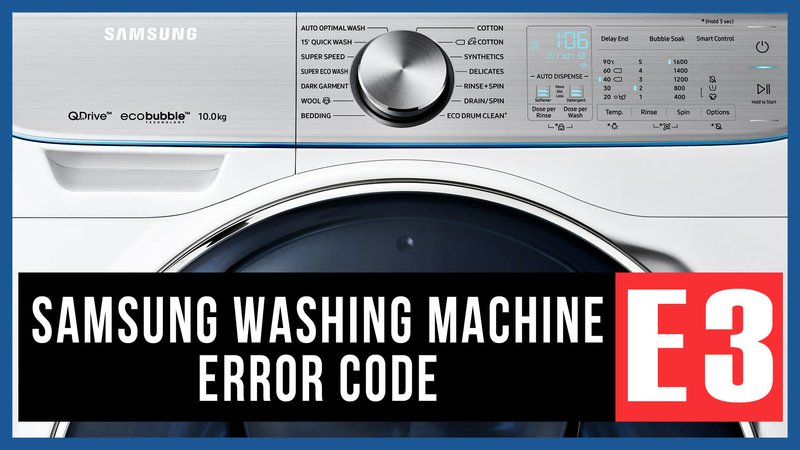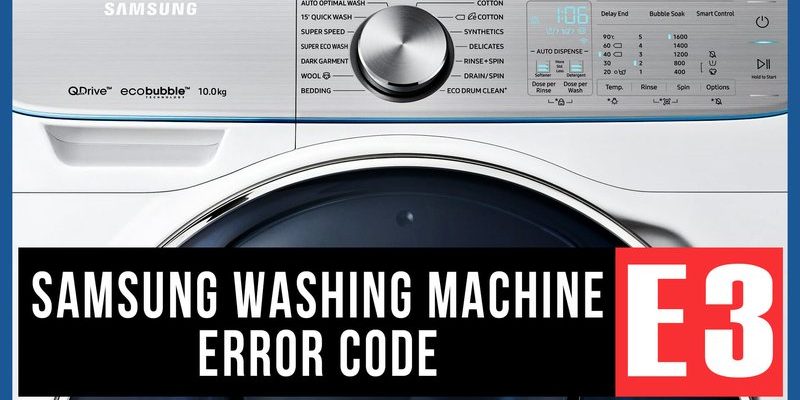
Think of it like this: imagine your washing machine as a friend trying to give you a heads-up about an issue. The E3 error code usually means there’s a problem with the machine’s motor speed sensor or that the machine is overloaded. In simple terms, it’s like your washer saying, “Hey, there’s a bit too much going on here, could use some help!” By understanding what this error code signifies, you can save time and avoid unnecessary stress or costly repairs.
Let’s take a closer look at what might be causing this issue and how you can address it. We’ll cover what the E3 error code means in more detail, explore its common causes, and give you some practical steps to solve this problem.
Understanding the Samsung Washing Machine Error Code E3
When your Samsung washing machine flashes an E3 error code, it’s essentially pointing out a potential problem with the motor’s speed sensor. This might sound technical, but let’s break it down. Think of the motor as the heart of your washing machine. It’s responsible for spinning the drum, allowing your clothes to swish around, getting all that dirt and grime out. The speed sensor is like the machine’s eyes, watching over to make sure everything’s spinning just right.
If the sensor detects that the motor isn’t spinning at the correct speed, it sends out the E3 error message. It’s similar to your car letting you know when you’re driving too fast or too slow. This alert allows you the opportunity to check things out before they escalate. In the case of washing machines, if the motor is under too much strain, it won’t perform effectively, and could even lead to bigger issues if ignored.
Most often, this issue arises from overloading. Imagine trying to run a marathon with a backpack full of bricks — your washing machine’s motor feels much the same if it’s overloaded with clothes. Recognizing the load capacity and ensuring you don’t overstuff the machine can prevent this error from appearing frequently. The next time you see this code, consider your recent loads — have they been too heavy?
Common Causes of the E3 Error Code
The E3 error can be a result of a few different factors. Beyond overloading, another common culprit is an imbalance in the load. Picture a seesaw; if one side is heavier, it tips. Similarly, if the clothes are all bunched up on one side of the drum, the washing machine struggles to spin properly, causing an imbalance which triggers the error code.
Another possibility is a blockage or restriction in the motor. If something is caught or wrapped around the motor — like a stray sock or tiny piece of clothing — it can prevent it from operating smoothly. This blockage is like having a stick caught in a bike wheel, making it hard to pedal. You may want to carefully inspect the area around the drum and motor.
Finally, it could be a simple glitch in the machine’s electronics. Yes, even machines have their off days! Just as rebooting your computer can solve a myriad of issues, sometimes a simple restart of your washing machine can clear a minor electronic hiccup. Unplugging the machine for a few minutes and plugging it back in is a good first step when facing these puzzling codes.
Steps to Fix the E3 Error Code
Now that you have a sense of what might be causing the E3 error, let’s walk through how to fix it. First things first, check if your washing machine is overloaded. Open the door, take out some clothes, and restart the cycle. This is like lightening the load so your washer can breathe easy.
If the machine isn’t overloaded, the next step is to redistribute the clothes evenly inside the drum. Give it a good spin manually when it’s empty. This helps ensure that everything moves smoothly once the machine is running. Think of it as spreading out those clothes like you would spread butter evenly over bread.
In cases where the problem might be a blockage, carefully inspect the drum and surrounding area for any foreign objects. Remove any items that might have found their way into places they shouldn’t be. For the more technical side, if you’re comfortable, you can examine the motor and speed sensor. However, if you’re not sure, it’s best to call in a professional to avoid any mishaps.
Lastly, if the error continues to persist, a reset might be in order. Power down the machine completely by unplugging it, wait a few minutes, and then plug it back in. It’s a simple trick, but very effective. If this doesn’t work, it might be time to consult the Samsung support services to ensure there’s nothing more serious at play.
Preventing the E3 Error Code from Reappearing
Prevention is always better than cure, right? So, let’s look at some proactive steps you can take to keep that E3 error at bay. One of the simplest ways is to always check the load capacity of your washing machine. It’s like knowing just how many groceries you can fit into one shopping bag. Keeping loads within the recommended weight helps the machine perform optimally.
Regular maintenance is also key. Make it a habit to clear out any stray items that might be lurking around the drum or in the machine’s nooks and crannies. Doing this regularly is like keeping your car clean and free of clutter so it runs better.
Additionally, spreading out clothes evenly before starting a cycle can prevent imbalances. Think of it as setting the stage for a smooth performance. While these steps might seem small, they can greatly reduce the chances of encountering the E3 error again and improve the longevity of your washing machine.
And there you have it! With these insights, dealing with the E3 error code shouldn’t feel like facing a daunting mystery. Address the issue with confidence, and you’ll soon have your washing machine running smoothly once more.
